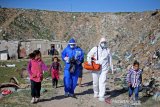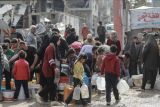Gaza, April 24 (Antara/Xinhua-OANA) - As the world celebrates the Earth Day on Wednesday, some 16,000 inhabitants living near the Gaza Valley in Gaza Strip are facing a growing unhealthy situation that has been going on for many years.
Gaza Valley is 9 kilometers long and goes from eastern Gaza to its west. Palestinians nearby are always complaining that they are infected with allergies, skin rashes and fungus, besides the abominated smell that comes out around the clock from the dried valley that is full of overloaded trash and sewage.
During the winter, the valley is filled with running rainwater which descends from the mountains of Hebron in southern West Bank and runs through the valley into the Mediterranean.
Abdullah Nweiri, a 25-year-old resident of the area, told Xinhua that the life of the population of Gaza Valley area had turned into "unbearable hell," due to the pollution over the past few years. "Life here is unbearable due to the bad smell and the spread of diseases that infect children."
People who live there are either farmers or shepherds, who always complain of their poor living condition. They cannot afford living in other areas but to stay in the Gaza Valley, which is considered one of the most polluted areas in the world.
They highlighted the difficulties of their life and the need for an immediate intervention to find a fast solution to end their suffering from pollution and health risks.
Experts say that the Gaza Valley area is witnessing a growing environmental catastrophe due to a record of accumulation of wastewater and solid waste, which generate diseases and epidemics affecting the lives of the people of the region.
A laboratory study published last year by Al-Azhar University in Gaza showed a very high percentage of fecal bacteria in water samples. The results of the laboratory analysis also showed that the percentage of oxygen content is low, which does not qualify for any activity.
According to locals, the Gaza Valley used to be the most significant natural resort in the Gaza Strip. Specialists said that the change of the area was due to the Israeli confiscation of its waters.
Israel constructed in early 1970 dams that block water from running into the valley's stream. Pumping sewage water and throwing rubbish into the valley also turned it into an abominated area.
Abdel Fattah Abed Rabbo, professor of environmental science at the Islamic University, told Xinhua that Israel's construction of dams around the valley turned the area into a semi-arid place, destroying its biodiversity as well as the the surrounding area of fertile soil for agriculture."
He pointed out that the lack of sewage pumps in central the Gaza Strip amid a great population growth over the last 10 years caused a sharp aggravation of the environmental crisis in the valley. He noted that the polluted water has already penetrated into the aquifer of the area.
Earlier, the Environmental Quality Authority in Gaza warned of the risk of turning the Gaza Valley into a large water pump of raw sewage into the sea.
The valley receives sewage from 45 percent of houses in central Gaza Strip. Since waste water does not connect to the sewage network, large amounts of raw sewage water pour into the sea without any treatment across the valley every day.
Rabah Sheikh, vice president of the Water Authority, told Xinhua the absence of drainage systems in central Gaza Strip, the expansion of sewerage networks and the untreated water that goes towards the valley are the main reasons for the devastated environmental crises in the valley.
He added that the exacerbating risk of this situation urged for an emergency intervention to push the implementation of temporary treatment of the sewage system that has been serving for four to five years.
In addition, he pointed out that they are working on a project to create a sewage treatment facility for Gaza city and central Gaza Strip, a radical solution to the crisis of the Gaza Valley.
However, Sheikh complained about the delay in constructing the central sewage treatment facility. He said the lack of funding and the continuation of the Israeli blockade hindered the delivery of construction materials needed for the project.










